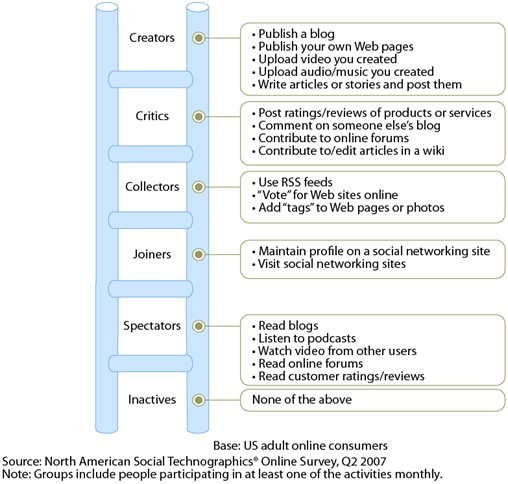Marketing in the Blogosphere
From The Yaffe Center
(→Who is Blogging) |
(→Who is Blogging) |
||
| Line 18: | Line 18: | ||
To better understand the discrepancy in blog readership as compared to blog writers, it is important to analyze the behavioral segments across social media. Charlene Li and Josh Bernoff’s “Social Technographics” studies are particularly insightful when reviewing levels of participation in social media and are currently regarded as the most complete framework for reviewing this phenomenon within Web 2.0 literature. (Reviews of Groundswell) The Social Technographics Ladder below illustrates the degrees of activity from participants across social media. Ranging from inactivity (“inactives”) to hyperactivity (“creators”), the largest group (48%) of US online adults are “spectators,” meaning they “consume what others produce.” (Li and Bernoff, Groundswell:Winning in a World Transformed by Social Technologies 2008, 45) | To better understand the discrepancy in blog readership as compared to blog writers, it is important to analyze the behavioral segments across social media. Charlene Li and Josh Bernoff’s “Social Technographics” studies are particularly insightful when reviewing levels of participation in social media and are currently regarded as the most complete framework for reviewing this phenomenon within Web 2.0 literature. (Reviews of Groundswell) The Social Technographics Ladder below illustrates the degrees of activity from participants across social media. Ranging from inactivity (“inactives”) to hyperactivity (“creators”), the largest group (48%) of US online adults are “spectators,” meaning they “consume what others produce.” (Li and Bernoff, Groundswell:Winning in a World Transformed by Social Technologies 2008, 45) | ||
| + | |||
| + | [[Image:Social_technographics_ladder.png|frame|center]] | ||
===Segmentation of Bloggers=== | ===Segmentation of Bloggers=== | ||
Revision as of 00:01, 16 May 2011
This page is under construction
Contents |
Acknowledgements
This page is largely adapted from "Joining the Conversation: Marketers, Meet the Blogosphere" written by Elizabeth K B Smith as a student at the University of Michigan Stephen M. Ross School of Business.
What is the Blogosphere?
Although many definitions of (we)blogs exist, the most basic explains that a blog is an online platform that enables one to write without format constriction, word choice, or topic; it can be updated as frequently as wanted and is generally displayed in reverse chronological order (Wikipedia n.d.)
Who is Blogging
25 million bloggers and 104 million blog readers in the US (eMarketer 2008) Although bloggers themselves may be early adopters, their readership (at 50% of the 200 M US online population) is not necessarily as innovative . The popularity of blogs has increased significantly over the past several years, with 346MM people worldwide reading a blog in the past month (about 34% of worldwide internet population) and 184MM reporting that they have started a blog (18% of worldwide internet population). (Technorati 2008) Similarly in the US, eMarketer reports 104MM blog readers (54% of US online population that read once a month) and 25.2 MM (13% of US online population) bloggers in May 2008. (Technorati 2008) Moreover, eMarketer expects readership in the US to reach 145.3MM (64% of US Online population) and the number of bloggers to be 34.7MM (16% of US Online population) by 2012 (see charts below). (eMarketer 2008)
To better understand the discrepancy in blog readership as compared to blog writers, it is important to analyze the behavioral segments across social media. Charlene Li and Josh Bernoff’s “Social Technographics” studies are particularly insightful when reviewing levels of participation in social media and are currently regarded as the most complete framework for reviewing this phenomenon within Web 2.0 literature. (Reviews of Groundswell) The Social Technographics Ladder below illustrates the degrees of activity from participants across social media. Ranging from inactivity (“inactives”) to hyperactivity (“creators”), the largest group (48%) of US online adults are “spectators,” meaning they “consume what others produce.” (Li and Bernoff, Groundswell:Winning in a World Transformed by Social Technologies 2008, 45)
Segmentation of Bloggers
Blog Metrics
Traditional media campaigns favor reach and ad response metrics to determine how successful a campaign was. However, the blogosphere incorporates metrics such as: relevance to readers’/bloggers’ lives and/or content of the blog; trust of the company/brand/product; engagement, and the buzz that the campaign generates (i.e. how many other people have talked about it across the blogosphere including Twitter “Tweets”).
Marketers and Blogs
Why Marketers Should Advertise with Blogs
Blog Sponsorship
Successful Blogosphere Marketing
ROI of Blogging
Practices to Avoid
Bloggers' Trust Issues
Credibility
Transparency
Influence
References
- eMarketer. "Blogs Key for Customer Communication." eMarketer. December 29, 2008. (accessed March 13, 2009).
- Li, Charlene, and Josh Bernoff. Groundswell:Winning in a World Transformed by Social Technologies. Boston: Harvard Business Press, 2008.
- Reviews of Groundswell can be found here: http://www.forrester.com/Groundswell/reviews.html. Similarly, Li and Bernoff consistently receive reviews of 8 or higher on the Social Technographics articles they have written for Forrester Research. Forrester has implemented their studies across several other authors as well using it as the prevailing framework for assessing participation in social media.
- Technorati. State of the Blogosphere 2008. December 2008. http://technorati.com/blogging/state-of-the-blogosphere/ (accessed January 2009).




